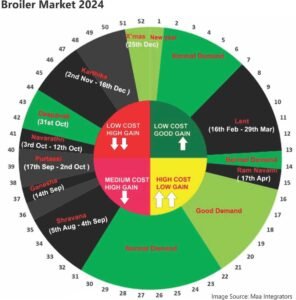Christmas & New Year’s seasons are causing a surge in egg and chicken demand, leading to price hikes while oversupply in the market due to the increased body weight of chicken is distressing the market. Poultry farmers anticipate further increases in the cost of production due to low maize and soya yields (major feed ingredients) caused by unfavorable weather conditions. The scarcity is prompting calls for maize imports to alleviate shortages, while the government’s emphasis on ethanol production from maize adds to concerns for the poultry industry’s supply challenges.
Several industry associations have penned letters to the Animal Husbandry Department requesting permission for maize imports. On December 23rd, a roundtable meeting, led by Ms. Alka Upadhaya, Secretary of the Department of Animal Husbandry and Dairying, featured representatives from various departments and industry associations. This strategic assembly convened key stakeholders, such as major companies, state governments, and industry groups, to discuss the challenges and strategies for exports of Indian poultry products. During the meeting, the poultry industry also voiced concerns about the rising prices of feed ingredients.
Think Grain Think Feed connected with various industry associations to discuss the ongoing situation and possible solutions to protect the industry.


Industry seeks government intervention in maize imports
In the plea, Dr. Ajay Deshpande, President, Vets in Poultry (VIP) underscores the urgency of the situation, highlighting the immediate threat to the poultry industry’s financial health. Poultry feed accounts for 80% of production costs, and the surge in local maize prices, compounded by inconsistent rainfall in major maize-producing states, is adversely affecting chicken production.
He argues that the current maize prices of INR 25 per kg throughout India are unsustainable for the poultry farming community. Anticipating a further increase to INR 28-30 per kg by February 2024, the association foresees a worsening situation post that date due to uncertainties in Rabi maize production. The industry relies on imports to bridge the demand-supply gap, but the existing 60% import duty on non-GMO maize is discouraging.
In response to the crisis,
VIP urgently requests the government to consider reducing the import duty on non-GMO maize from 60% to either NIL or a maximum of 15%.
He argues that previous instances of maize imports have not adversely affected local farmers; instead, they played a crucial role in stabilizing demand and supply, benefiting both farmers and the poultry industry, and ensuring affordable access to nutritious protein for the people of India.
Soybean woes increase risks for the Indian poultry industry
Suresh Deora, Chairman, CLFMA of India, an association representing All-India manufacturers of compound feed expressed similar concerns. In the letter, the chairman highlighted that maize prices are currently at INR 25,000 per MT, while international prices for non-GM maize are at USD 275 per MT CNF Mumbai, equivalent to approximately INR 26,000 per MT for plant delivery. He underscored the impact of India’s ethanol blending program, which may divert 25 lakh MT of maize for ethanol production.
The industry is expected to encounter challenges with decreasing carry-over stock of soybean seed, making soybean meal more crucial for the poultry feed industry, especially as alternative protein sources like rapeseed DOC and groundnut DOC experience record-high prices.
The association urged the government to take positive action by permitting duty-free maize and GM soybean meal to support poultry and dairy farming in India.
Maize & Indian poultry growth: A substantial disparity
Over the last decade, maize crop growth has been at 4.5%, while the poultry industry has experienced a growth of 8.5-9%. This disparity highlights the anticipated maize shortage for the poultry industry, making sustainability challenging. The government’s plan to promote maize for ethanol would exacerbate the situation.
Representing the All-India Broilers Breeders Association, Zoya Afreen Alam, Director of IB Group, suggested that duty-free maize imports could aid the industry in managing this crisis, especially given increased insurance costs due to the ongoing Ukraine war.
Implementing stock holding capacity on domestic market traders is a potential short-term solution.
For a long-term fix, she proposed allowing GM crop cultivation, potentially doubling crop production and benefiting both agriculture and poultry farmers.
Ranpal Dhanda, President of the Poultry Federation of India (PFI), highlighted the 30-35% cost difference in feed ingredients gives an edge to American and Brazilian poultry industries in exporting to the Asian market. In contrast, India, with its high production costs, holds a mere 0.3% share of the Asian export market.
He proposed a potential solution for duty-free maize imports, emphasizing the need for a long-term strategy. Mr. Dhanda suggested motivating agriculture farmers to shift towards maize production by offering a buy-back guarantee at MSP or a rate higher than MSP. In alignment with this, PFI has initiated discussions with various seed companies and plans to experiment with different seeds to optimize production, thereby supporting the farming community.
He anticipates stability in maize prices due to recent developments, such as the removal of the sugarcane ban for ethanol production.
Vasant Kumar Shetty, former president of Poultry Farmers & Breeders Association-MH, expressed that while Indian maize farmers deserve fair compensation, it is crucial to safeguard the poultry industry. Rising feed ingredient costs would elevate the cost of production, potentially negatively impacting egg and chicken consumption. Last year, the average production cost was INR 91 per kg, with a selling price of INR 92 per kg, indicating a slim margin for the sustainability of the industry.
To address this, Mr. Shetty proposed that the Indian government should procure maize at MSP from farmers and supply it to the industry to help maintain production costs.
Dr. Pattabhi, Treasurer of the Institution of Veterinarians of Poultry Industry (IVPI), a leading association of poultry veterinarians, communicated his concerns over a 30% reduction in maize crop due to monsoon failure, average quality, and stock holding by traders during a phone call.
He suggested that allowing some imports would support the industry, with traders likely releasing stock once imports are permitted. This, according to Dr. Pattabhi, would stabilize prices at the current level of INR 24,000-25,000 per MT; otherwise, there is a risk of prices reaching the range of INR 27,000-28,000 per MT by February 2024.
Oversupply in the market
Regarding market oversupply, Mr. Shetty suggested industry unity in selling birds at 2-2.3 kg to prevent losses. Planning production based on expected demand is essential to avoid market disruptions and ensure profitability through balanced supply and demand.
Three years ago, he initiated National Chicken Day to raise awareness and boost chicken consumption, a concept embraced by the industry. He emphasized the importance of industry collaboration across various platforms for such initiatives.
Ms. Alam noted that increased body weight led to a market dip, but the holiday season, including Christmas and New Year, is expected to revive the market with heightened demand, consequently driving prices up. She emphasized that collaborative efforts among associations and industry members are essential to mitigate the volatility in live bird prices.
Attributing the current overweight birds to favorable weather conditions, even affecting South India with an average body weight of 2.7-3 kg, Dr. Pattabhi anticipates this situation to persist until year-end. He suggested the industry shift focus to fresh chilled chicken with each integrator planning its outlets. As an association recommendation, they propose that members and farmers adhere to the discipline of culling parent stock by 64 weeks.


Mr. Dhanda discussed efforts to address market oversupply. In a recent meeting with North India farmers and PFI members, the association advised to start bird culling at 1.9-2.0 kg within a 32-day cycle instead of allowing it to sell at 3 Kg or more at a 40-day cycle.
Conclusions
The poultry industry seeks to assist maize farmers while safeguarding its interests. A consensus across discussions highlights the common suggestion that the government should intervene by permitting non-GM maize imports and reevaluate the decision to divert maize for ethanol production. Achieving market supply and demand balance necessitates a concurrent focus on discipline and promotion.
Disclaimer: A special thanks to Dr Jeetendra Verma, Dr Sujit Kulkarni, Ricky Thaper, and Dr Santosh Ire for their valuable input.













